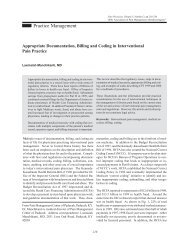ASIPP Practice Guidelines - Pain Physician
ASIPP Practice Guidelines - Pain Physician
ASIPP Practice Guidelines - Pain Physician
Create successful ePaper yourself
Turn your PDF publications into a flip-book with our unique Google optimized e-Paper software.
Manchikanti et al • <strong>ASIPP</strong> <strong>Practice</strong> <strong>Guidelines</strong><br />
59<br />
Kikuchi et al (415) studied the therapeutic effect of transforaminal<br />
nerve root injections in 332 patients. They reported<br />
that this procedure not only had therapeutic effect<br />
but also had great diagnostic value in functional as well as<br />
morphological aspects. They reported that 22 of 45 patients<br />
with disk ruptures, 30 of 39 patients with spondylosis,<br />
and five of six patients with degenerative spondylolisthesis<br />
all experienced more than 6 months of pain relief<br />
and thus were able to avoid surgical intervention. Furthermore,<br />
they reported that, over the long term, relief was<br />
seen in 64% of these patients.<br />
Manchikanti et al (553) compared the three routes of epidural<br />
steroid injections in the management of chronic low<br />
back pain. This retrospective evaluation included 225<br />
patients, randomly derived from a total sample of 624 patients<br />
suffering with low back pain from a total of 972 patients<br />
referred for pain management. The evaluation was<br />
performed by an independent evaluator. The study design<br />
included three groups: Group I, which received interlaminar<br />
epidurals with a midline approach in the lateral position,<br />
with entry between L3/4 or L4/5 in nonsurgical patients<br />
and above the scar either at L2/3 or L1/2 in postsurgical<br />
patients, using a loss-of-resistance technique; Group II,<br />
which received caudal epidurals, the procedures being<br />
performed in prone position, under fluoroscopy, with confirmation<br />
of the position by injection of contrast; and Group<br />
III, which received transforaminal epidural corticosteroid<br />
injections, using either sacral or lumbar transforaminal technique<br />
under fluoroscopy. The results of the study showed<br />
that all three routes of administration of epidural corticosteroid<br />
administration were clinically effective, though administration<br />
by caudal and transforaminal routes was more<br />
successful in obtaining longer term relief. Further, this<br />
study also showed that the transforaminal injections were<br />
the ideal, as the most significant improvement was noted<br />
with the least expense compared to fluoroscopically directed<br />
caudal epidural, and to blind interlaminar epidural.<br />
This study showed significant relief, which was defined as<br />
greater than 50% per procedure for all patients in the study<br />
as 3.45 +/- 0.17 weeks, 6.06 +/- 1.27 weeks, and 7.69 +/-<br />
1.20 weeks for blind intralaminar epidural, fluoroscopically<br />
directed caudal and transforaminal epidural injections,<br />
respectively.<br />
Devulder (627) also studied transforaminal epidural injections,<br />
which he termed nerve root sleeve injections with<br />
corticosteroids; however, they were in combination with<br />
hyaluronidase. In a study of 20 patients with persistent<br />
pain after surgery, ranging from 1 to 9 years in duration<br />
and diagnosed as failed back surgery syndrome, they reported<br />
that 55% of the patients reported greater than 50%<br />
relief at 1 month, while 50% of the patients experienced<br />
continued relief after three months.<br />
Slipman et al (628), in a retrospective analysis with independent<br />
clinical review, evaluated the role of therapeutic<br />
selective nerve root block in the nonsurgical treatment of<br />
atraumatic cervical spondylotic radicular pain. Of 20 subjects,<br />
10 men and 10 women, with a mean age of 56.6 years<br />
and an average symptom duration of 5.8 months, were<br />
treated with an average of 2.2 therapeutic injections. They<br />
reported an overall good or excellent result in 60% of the<br />
patients, with significant reduction in pain scores, as well<br />
as significant reduction in medication usage.<br />
Of the five prospective clinical trials available for evaluation<br />
of transforaminal epidural injections, three were considered<br />
of moderate quality (622-624) and the remaining<br />
two were considered of low quality (571, 625). In terms<br />
of the evaluation of the type and strength of efficacy evidence<br />
of transforaminal epidural injections is level II to<br />
level III, strong to moderate. Level II - strong is defined<br />
as evidence with research-based evidence with at least one<br />
properly designed randomized controlled trial of appropriate<br />
size and with 60 patients and high quality or multiple<br />
adequate scientific studies. Level III - moderate is<br />
defined as evidence obtained from well-designed trials<br />
without randomization, single group prepost, cohort, time<br />
series, or matched case controlled studies.<br />
Percutaneous Lysis of Epidural Adhesions<br />
Percutaneous epidural adhesiolysis, lysis of epidural adhesions,<br />
percutaneous neuroplasty, or epidural neurolysis<br />
is an interventional pain management technique that played<br />
an active role since its emergence during the latter part of<br />
1980s in managing chronic intractable low back pain (632,<br />
633). Postlumbar laminectomy syndrome or pain following<br />
operative procedures of the spine is a common entity<br />
in modern medicine (261-292). Ross and coworkers (267),<br />
in a study of the relationship between peridural scar evaluated<br />
by MRI and recurrent radicular pain after lumbar<br />
discectomy, showed that subjects with extensive peridural<br />
scarring were 3.2 times more likely to experience recurrent<br />
radicular pain. Park and Watanable (269) analyzed<br />
the frequency and location of lumbar and ventral dural<br />
adhesions in elderly cadavers, showing significant evidence<br />
of adhesions in 40% at L4/5 levels, in 36% at L5/S1 levels,<br />
and in 16% at L3/4 levels. Even though epidural adhesions<br />
are most commonly observed following surgical<br />
<strong>Pain</strong> <strong>Physician</strong> Vol. 4, No. 1, 2001
















